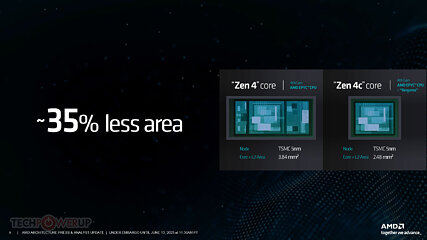According to AMD’s vice president, the company will not adopt Intel’s hybrid architecture strategy but rather intends to launch Zen 5 as soon as feasible for desktops. David McAfee, corporate vice president and general manager of the Client Channel Business at AMD, discussed the company’s current product line in the interview as well as its forthcoming releases and intended growth. The AMD Ryzen AI was brought up first, which he said takes up a sizable portion of the new Ryzen 7040 mainstream laptop line, also known as “Phoenix.”
Here, David’s explanation of the hybrid CPU design is crucial. The conventional Zen 4 and the density-optimized Zen 4C are two different sorts of Zen 4 cores that AMD now offers, he claimed. David further explained that using P-cores and E-cores is one approach to create a hybrid CPU, but that this was not at all what the red team had in mind.


He said that this was because it was more challenging to match the best cores for each operating system and set of programs when using two distinct cores with varied ISA capabilities. With the help of its Thread Director technology, Intel was resolving this issue, but he said that AMD would employ comparable but entirely distinct tailored designs for its own hybrid strategy.
Hybrid client and server CPUs are already in development, AMD CTO Mark Papermaster stated in a previous interview. He said that it was well known that Zen 4 and Zen 4C would use the same ISA, with just small variations that would prevent them from being considered entirely different chips. He emphasized that using the appropriate core for the appropriate tasks is more crucial. According to AMD, such cores would be of limited use on unrestricted platforms like desktops but would be of more use in restricted designs like laptops.
According to him, AMD’s hybrid strategy will likely be adopted considerably more swiftly in the laptop market, with the first items arriving with the next Strix Point APU range.
David also discussed Zen 5 and how the company is moving swiftly to get its cutting-edge architecture on desktops as soon as feasible. According to him, the chip architecture is already on schedule to become a Ryzen 8000 desktop CPU with extra RDNA 3.5 graphics cores by the end of 2024.
It is also emphasised that the relationship between the number of cores and the bandwidth is linear. You may raise the number of cores as much as you like and boast, “Hey, we have the most cores/threads on our chip,” but if the core bandwidth isn’t accessible, it won’t matter. Performance won’t be impacted linearly by the extra cores, he claimed. According to him, this kind of architecture would result in performance reduction, which is a drawback of dual-channel memory devices. We could see another increase in the number of cores whenever faster memory is made available for greater bandwidths on these platforms, but for the time being, it appears like they will continue with 16 cores in the Zen 5 series.
Speaking of APUs, it appears that AMD has already begun work on Phoenix AM5 desktop processors because there is a need for them. He claimed that while the OEM market, which requires a chip that can house a GPU and enable users to do all of their responsibilities in an SFF or commercial PC, is surely large enough to justify such a device, is not as large as the DIY market. AMD is stating that it will undoubtedly back PC users who desire such processors if there is a demand for them.
That’s particularly positive, he added, as there have been several rumours suggesting that AMD Ryzen 7000G or Phoenix AM5 desktop APUs will not launch until later this year or early 2024. Since these APUs provide a lot of value in the entry-level market, especially when taking into account the costs for discrete GPUs, which are difficult to find for under $200, one would think that AMD could realise a decent DIY and OEM release. Gamers would benefit greatly from a sub-$200 CPU with an RDNA 3 GPU that provided performance comparable to a $100–$150 discrete GPU, he claimed.
Source:igorslab.de


